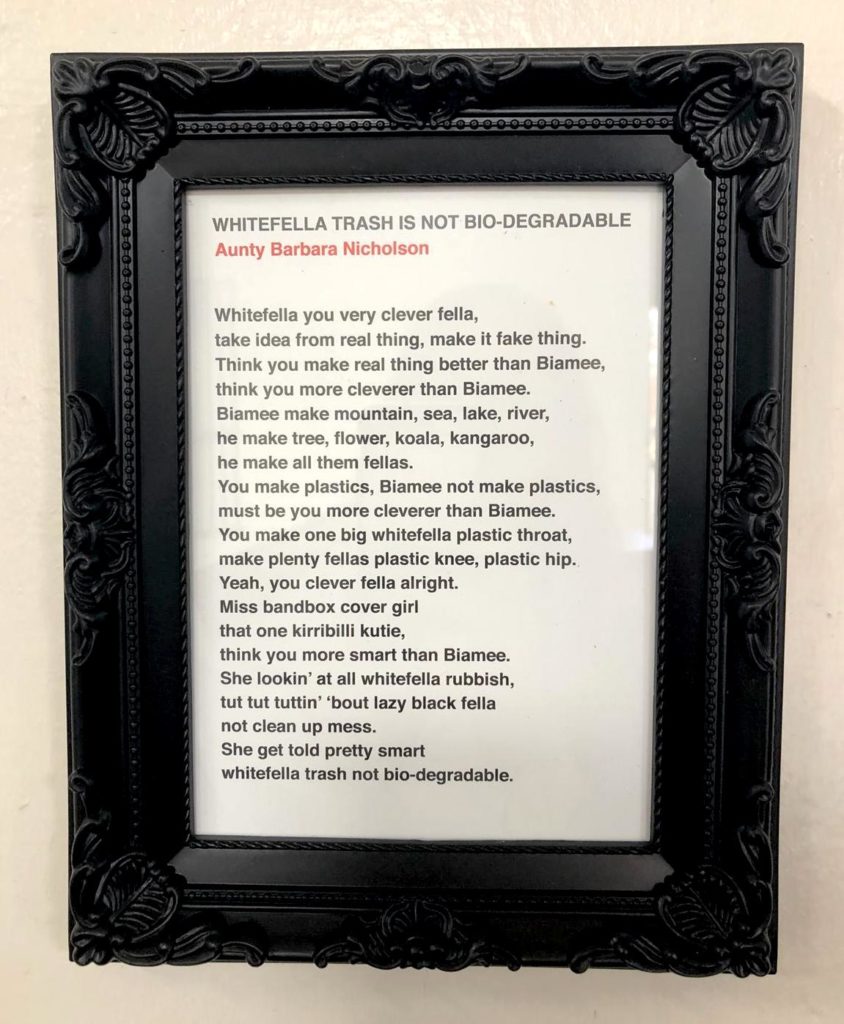
One month ago, we (alongside about 100 artists and collectives from around the world) launched our new artworks at NIRIN, the 2020 Biennale of Sydney. Then, not 2 weeks later, the exhibition was shut down thanks to COVID19. Perhaps you were one of the lucky ones who managed to get around and see the works? If not, here is a little “virtual tour” of the Plastic-free Biennale Artwork on Cockatoo Island.
(Meanwhile, the Biennale itself is in the process of building an online experience of the whole exhibition – check it out over here).
Our work is presented in Building 101, which is the former “Paymaster’s Office” at Cockatoo Island. The island was a major site for shipbuilding, and this little edifice housed a safe where all the cash was stored. Here’s Kim Williams on the threshold of Building 101, under the just-erected, hand-painted Plastic-free Biennale sign…
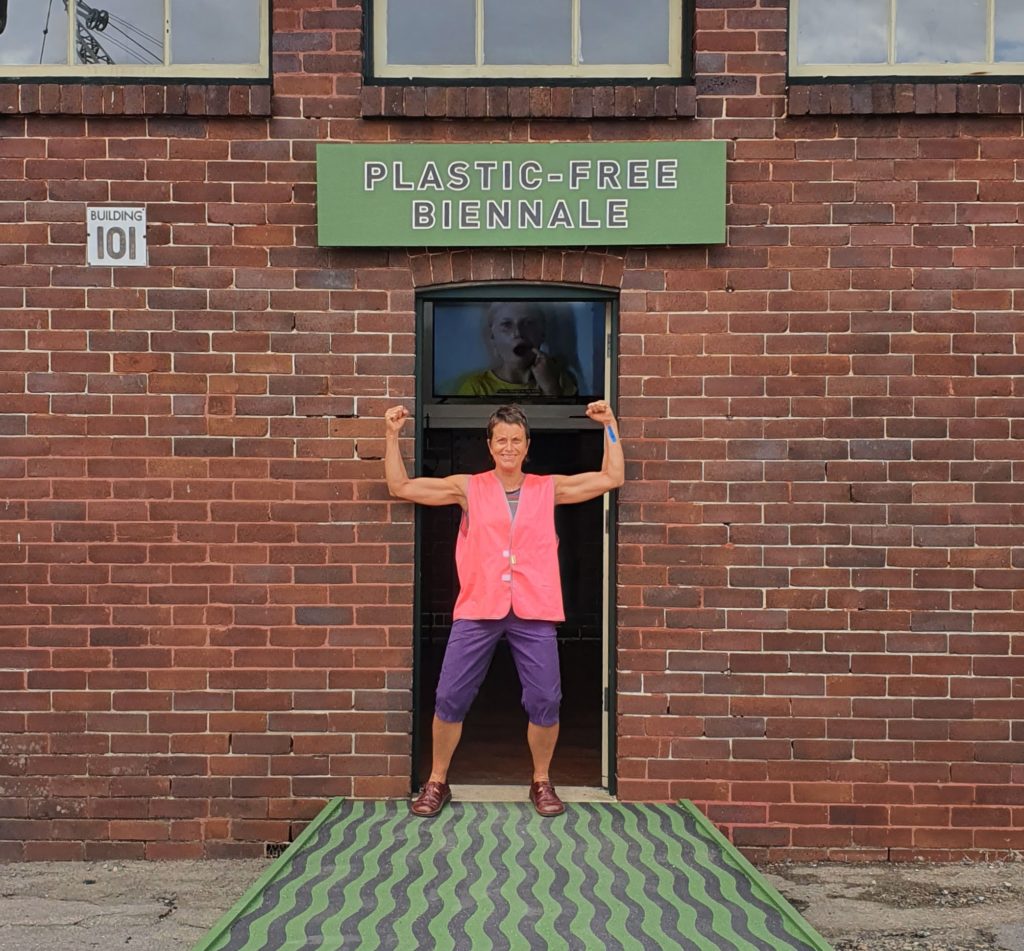
Kim’s standing on a ramp made of plywood, with a custom-painted grey and green design which has a perspectival, “vanishing point” effect. The ramp is there for practical purposes, to enable visitors who use wheelchairs to come into the space. We worked with Ed Horne of bujwak studio (chief maker at Cockatoo Island for the Biennale) and his team to make and paint the ramp, as well as artist Mickie Quick on the precise layout of the squiggle design.

The picture above shows what you’d see if you walked up the ramp and were standing at the threshold of the room. Four curved wooden benches with black tops; a digital screen on top of the old safe at the far end of the room; and on either side, blackboards with texts and images.
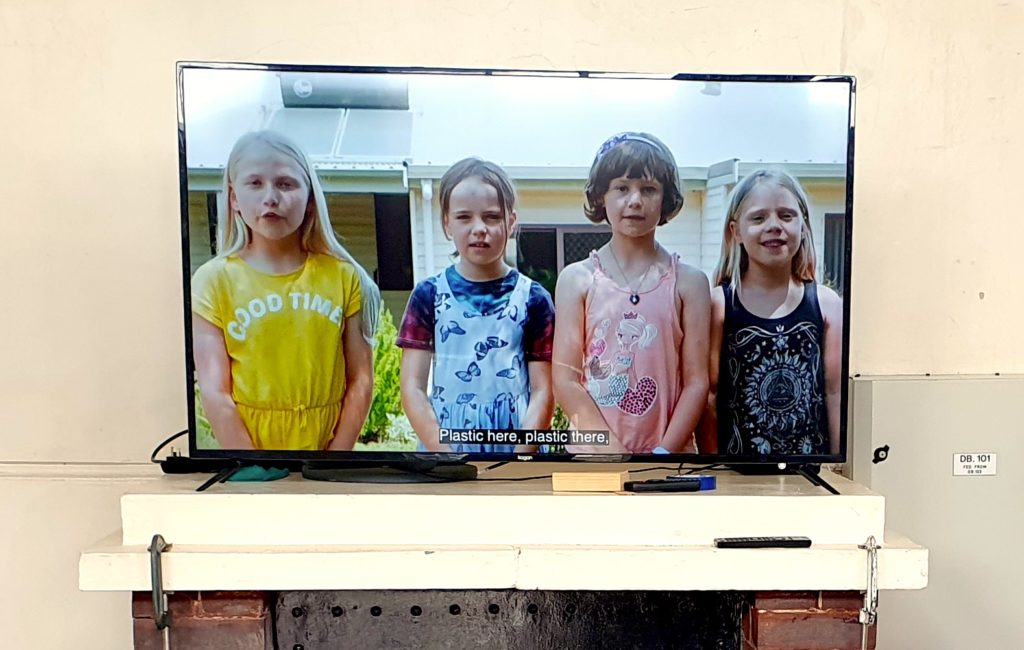
The telly on top of the safe has this wonderful video featuring a bunch of local Wollongong kids we worked with to make a song called Plastic in the House. The kids decided to form a music group called The Plastic Highlighters. They were happy enough to have their work featured in the Sydney Biennale, but insisted that we create a YouTube channel for the video (the pinnacle of cultural achievement for the 8-10 year old set). If you click on the image below, you can watch the video on YouTube!

But back to building 101… imagine you’re standing in the middle of the room, watching the video. Surrounding you on all sides are these curved benches. There are 4 of them, and the arrangement makes a circle with gaps you can move through. We had envisaged this space as our headquarters during the Biennale (March to June), and we would convene here each week with our team to progress our research, and interact with the public and the Biennale staff. Alas, that aspect of our project is not to be (some of it has gone online of course…).
But the “hub sections” as we called them were not only there to create an embracing space for meetings – they were also intended as a gentle introduction or primer to the overall theme of our project – plastic. So, in each benchtop there are two glass “windows” (square and circular), and each of them features one of the key groups of plastics, indicated by numbers one to seven. Typically, these numbers are used to show what a plastic object is made from, so that local councils can sort and recycle them correctly.
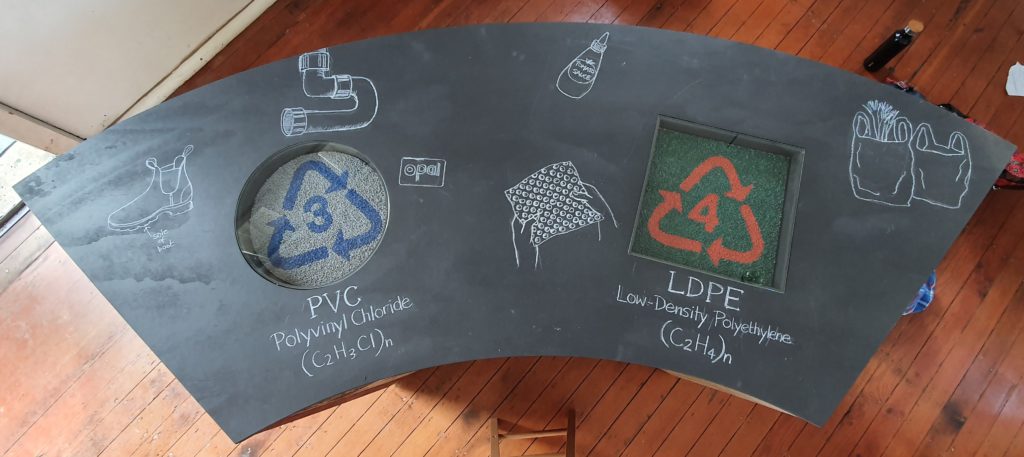
These coloured number pieces are rendered, in a sort of mosaic-style, with diverse colours, using plastic “nurdles”. Nurdles are the tiny pellets of plastic from which many moulded plastic products are manufactured.
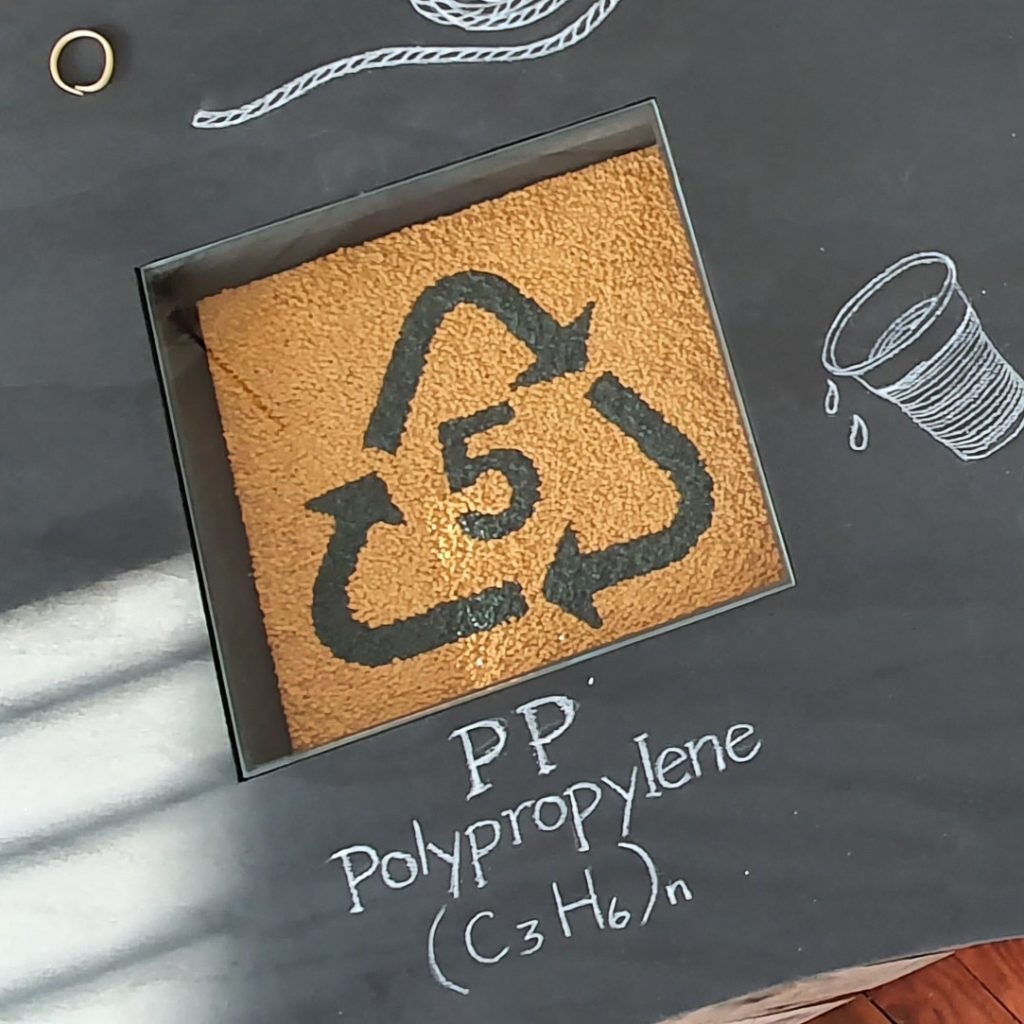
On the surface of the benches, chalk drawings show some typical plastic products that use each type of plastic (bubble wrap, plumbing pipes, sauce bottles, you name it!)
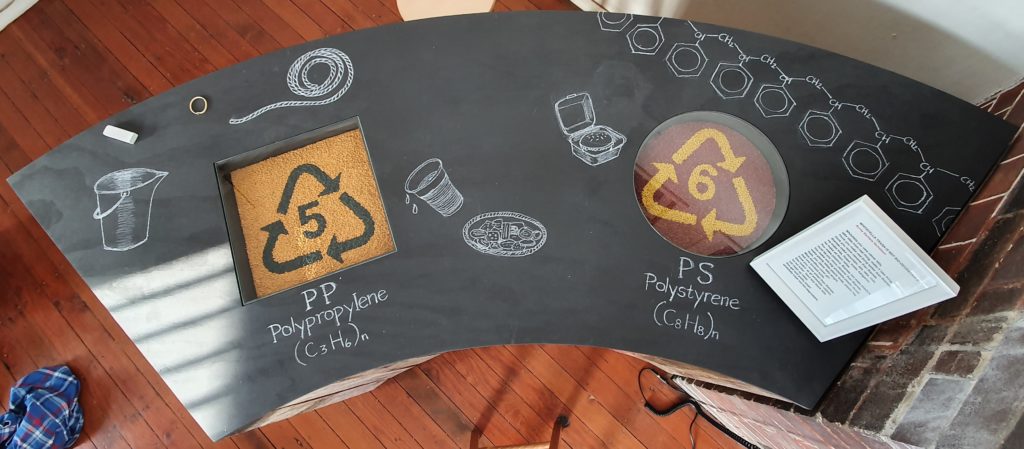

There’s also a round window filled with a mix of coloured nurdles – this is shown at the right on the image below:


If visitors were interested, we could take off the glass top, and allow them to plunge their hands inside, so they could feel the nurdles for themselves. Kind of like feeling sand run through your fingers, but … plastic. And of course, nurdles are commonly found as microplastics washed up along shorelines all around the world…
Continuing with our tour…
Beyond the boundaries of the “hub”, on either side of the room, there are two “blackboards” each about three metres wide. At the right is a text piece we call the “versus” drawing. Its longer title is “BUSINESS-AS-USUAL BIENNALE -VS- “PLASTIC-FREE BIENNALE”. If you click on the image below you can see a larger version of it:

The versus drawing is not intended to be “correct” in any way! Rather, it’s meant to provoke discussion by posing a series of impossible dichotomies. For example, a “business-as-usual biennale” would allow artists ultimate autonomy in decision making around materials, even if this results in environmental pollution – whereas a “plastic-free biennale” would have a policy forbidding this, effectively intervening in the aesthetic autonomy of the artist…
In this context, when we say “PLASTIC-FREE” we are referring to a biennale which makes all sorts of transformations (not just the elimination of plastic).
If you turn around now, on the opposite wall is another blackboard which houses three lithographic prints produced at Big Fag Press (Mickie Quick did the design and printing with us). These prints explore different aspects of the project in detail. Surrounding the prints, framing them, are some little creatures, massively enlarged and drawn in chalk – zooplanktons. These are among the building blocks of fossil fuels, which of course are the basis of plastics manufacturing.

The zooplanktons are mascots for our project, they show up here and there, within the prints and on some of our publicity materials… For example, the print on the left which has all the hexagonal shapes has some zooplankton swimming in and out of the texts. This piece tells histories (accidental and on-purpose) of the invention of plastics over the last hundred years or so. The little prawny zooplanktons remind us that the molecules in plastic, at some point in their evolution, were once part of the bodies of living creatures. Here’s an enlargement of that print:
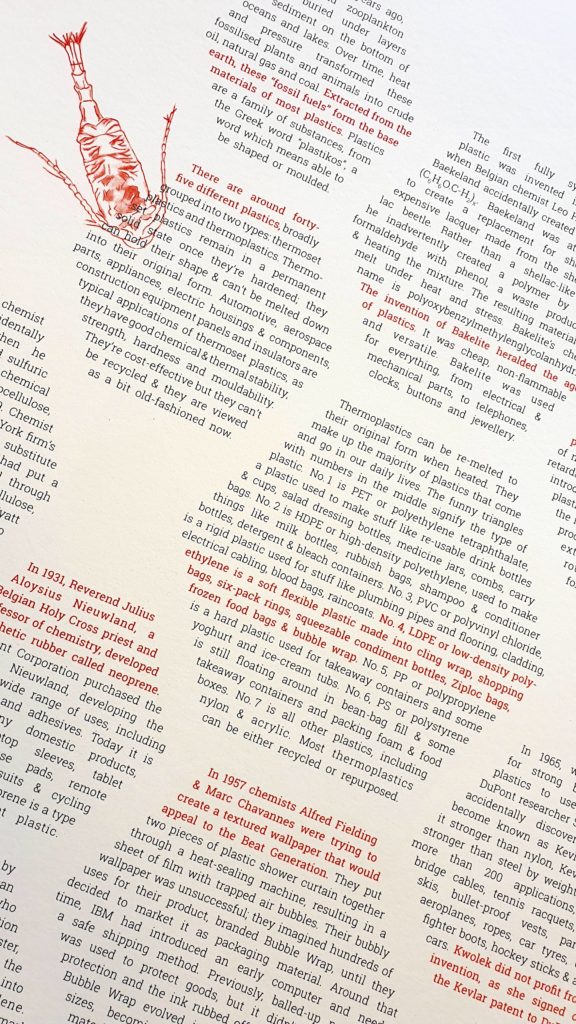
The print in the centre of this blackboard is like a wall of text – we refer to it as a “concrete poem”. It’s the “household plastic inventory” that we developed early on, as a sort of manifesto for the Plastic-free Biennale project, to gesture at the overwhelming endless presence of plastics in our everyday lives. You can read more about the concrete poem at this post here. (Click on the image below to see it much larger, or as a PDF here):

Finally, on the right is a circular graphic, which we call our “hub” print. It borrows its form from the hub benches in Building 101. The hub print is a dialogue between Kim and Lucas, segmented into four sub-headings: Digging Up, Speaking Up, Owning Up, and Washing Up. These four “Ups” were the categories we initially chose, rather arbitrarily, to organise our labour. Another way of looking at them could be: research and development, public outreach, organisational consultancy, and taking responsibility. Or something like that (although the categories often overlap). There is really no beginning nor end to this dialogue – you could start and finish wherever you want. The print could even be hung “upside down”. (Again, click on the image to see it bigger, or view it as a PDF):

Phew! So, that’s your virtual tour of Plastic-Free Biennale at Cockatoo Island. The only thing missing from this tour is people’s bodies. So here are a few photos from the Biennale vernissage before we all started to radically distance our bodies from one another. This first picture shows Plastic-free Biennale team members Juundaal Strang-Yettica and Amber Jones with visitors in Building 101:
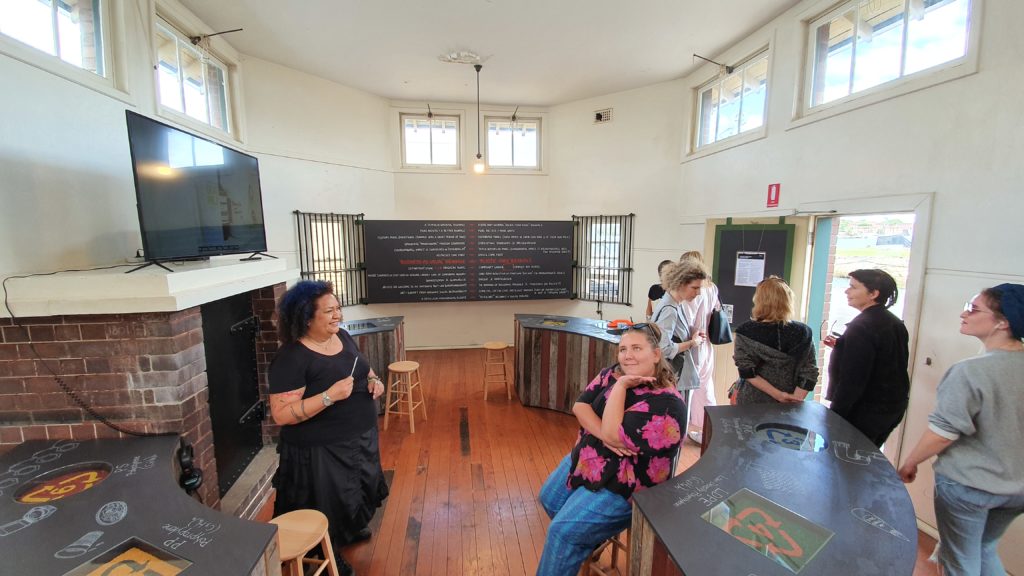
And in this one, Kim Williams engages in conversation with a punter:
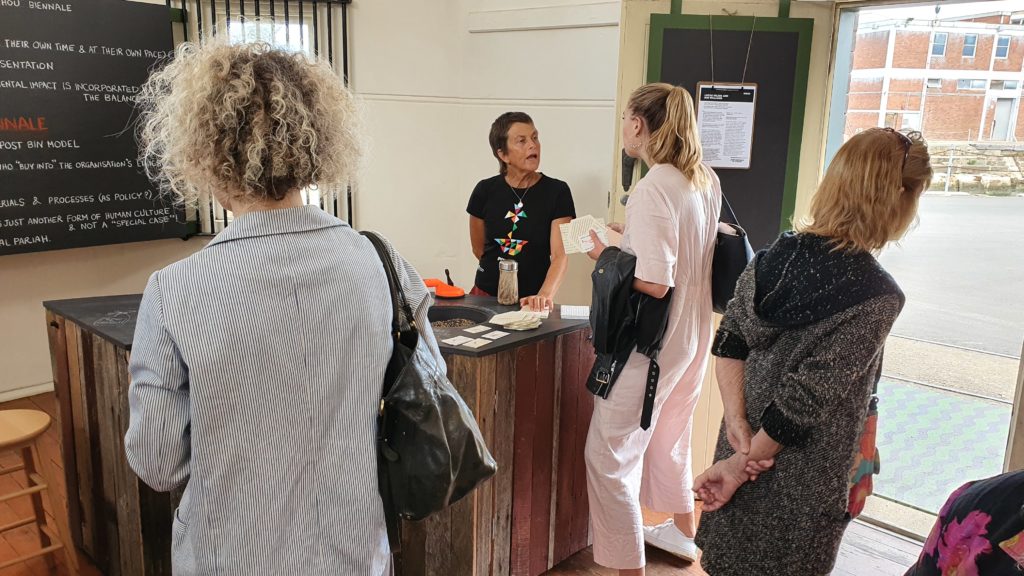
Oh, one last thing before you leave Building 101 and continue your tour of Cockatoo Island…
As a small coda to the installation, we hung a print of a new poem by Wadi Wadi Elder Aunty Barbara Nicholson. It’s called “White Fella Trash is not Biodegradable”. (You can read more about this work alongside our other manifesti here). The print is, of course, gloriously framed in baroque plastic:
